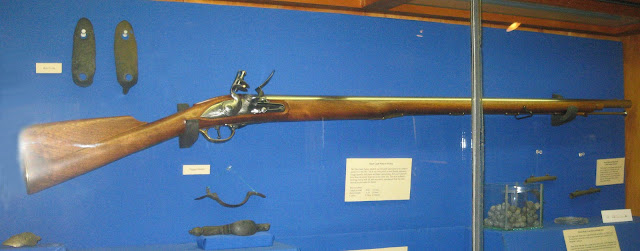The International Clay Target Championships are being held this week on Norfolk Island and the shooters may enjoy reading about a very special musket on display in the Pier Store Museum. We have a replica brown bess musket, officially known as a Short Land Pattern Musket on display with our HMS Sirius collection. During the Sirius expeditions recovering artefacts from the wreck site of HMS Sirius Flagship of the First Fleet, a number of brass fittings from this type of musket were found. The replica helps with understanding exactly where they came from on the gun. Myra Stanbury includes the following information the Short Pattern musket in the illustrated catalogue of Sirius artefacts.
At the time that the Sirius set sail from England, Short Land Pattern flintlock muskets were standard issue for troops, although in practice both Long and Short Land muskets may have been supplied. The Land Pattern series of muskets had been introduced c1730 and served as the basic pattern for British service muskets until the outbreak of the French Revolutionary Wars in 1793. The Short Pattern was officially sanctioned in 1768 and by 1790 had become the standard infantry musket of the British Army.
The overall length of the musket was 581/8 in (1.5m), the barrel length 42 in (1.06m), and the calibre 0.78 in (19.8mm). Brass furniture for firearms was manufactured by brass founders in London or Birmingham according to patterns issued by the Board of Ordinance. The finished components would be sent either to the board’s contractors or directly to the central depot, the Tower of London. From there, sets of components were distributed to a relatively small number of London gun makers known as ‘rough stockers and setters up’ who smoothed and finished the rough wooden stock blanks and assembled the weapons. The First Fleet took along 200 Short Land muskets and twelve sergeants’ carbines, probably Grenadier Sergeants’ Carbines with bayonets, for the marines.
Three brass ramrod pipes, two trigger guards, two butt plates and a wrist eschutcheon were all recovered from the wreck site. Our replica was made in the USA and took several months to arrive due to strict controls on the carriage of weapons aboard aircraft. It is a beautiful piece that shooters and non-shooters alike can appreciate. It helps us to perhaps picture a marine or soldier in 1790, standing on the deck of the Sirius and loosing their musket overboard at that terrible time of impact as the wrecking occurred.


No comments:
Post a Comment